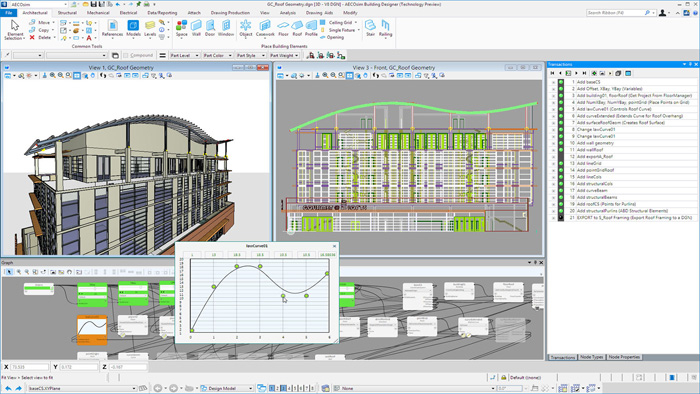Moving 3D CAD and BIM software to a hosted or remote environment can be a complex business. Adam Jull from graphics virtualisation specialist IMSCAD Global walks you through your options
When a business has always relied on traditional workstations, understanding newer, off-premise options can be confusing at best and a minefield at worst. The noise coming from a crowd of vendors keen for your business probably won’t help.
Nvidia GRID, Intel, AMD Citrix, VMware, HPE, Dell, Cisco and many more offer various solutions for moving your 3D CAD/BIM and other graphical applications and desktops to hosted or remote environments. Then there’s Amazon Web Services (AWS), Microsoft Azure, IBM and others, who will say they can run your graphical workflows in the cloud. And even once you’ve made your choice, you’ve still got to get your software deployed successfully. In this article, we hope to demystify the decisionmaking process and explore why customers choose one option over another.
Performance is everything
Users of graphical software are a demanding bunch, who expect design applications to perform in the cloud just as well as they do on a local workstation. It’s not an unreasonable request.
More and more customers want to try the public cloud (AWS, Azure, IBM) over setting up a private cloud (buying servers), but renting infrastructure can be expensive in the long run.
Recently, IMSCAD Global has seen an uplift in more project-based cloud deployments. This is where customers set up a six-month design project for 30 users, for example, utilising the cloud to rent servers and infrastructure over this period, and then at the end, tear it all down. Customers can then make this an operational expense and account for it within the cost of a project.
Nvidia GRID, AMD, Intel, Citrix and VMware can all have their place in the solution offered, but the skill is around understanding the customer workflow. Experience does count in understanding how the applications are used. AutoCAD, Revit, MicroStation, ArcGIS, Inventor, SolidWorks, Siemens NX and Catia are just some of the key applications, plus there are multiple other plug-ins and tools that are needed by design groups to do their work effectively. Then you need to know how maybe 100-plus design applications will run in a virtual environment.
The answer should be the same, but as always with deployments of this size, a certain amount of tweaking of Citrix and OS policies, along with distributing resources properly, should deliver the right result.
A good example is an IMSCAD Global customer that deployed a Citrix with Nvidia GRID solution within IBM Cloud. The customer stated that the performance was better than its current local workstations in over ten sites across the US. The customer now runs over 300 AutoCAD and Revit users in IBM Cloud , doing BIM and running with Revit models over 3GB in size. It can be done – but it needs to be properly planned.
The elephant in the room here, of course, is ISV licensing policies. These are still stuck in the workstation world.
Autodesk, Dassault Systèmes, Siemens and so on are making good progress, but issues still remain, adding to the complexity for customers. They may opt for private clouds for safety, but of course, that is just a halfway house to going ‘full public cloud’. Even today, many ISVs still state that you cannot run your license server in the cloud or outside of your domain. It’s crazy, but true.
There are always ways around this. They typically involve speaking to your ISV, so they can understand how you would like to do it. But let’s not forget designers may need at least ten different tools from different providers, so these discussions can become complex. You can always buy a direct VPN link into your cloud provider of choice, which can solve the issue, as your licensing server can then stay within your own network.
Normally, you may want a single sign-on process for users (meaning only one login on their device/workstation), plus Active Directory access, which would require a physical link to the cloud provider. Ultimately, this will just add to the cost and time to deployment. We tend to always deploy a Netscaler SSL VPN for remote access to any graphical- based remote environment.
GPU resources
Current GPU-based cloud offerings can vary in terms of what resource you get.
The reality is that AWS and Azure offer shared resource solutions, which can be great for certain use cases and users, but if you want to work on it eight hours a day with heavy design applications, the jury is still out.
It’s quite hard to scale up and be certain of how many users you can get working effectively. In a private cloud, of course, you can do what you want with the resources you have, but there is a significant upfront investment required. In IMSCAD Global’s view, these heavy users need resources to be guaranteed and here, VDI with XenDesktop really will work. Dedicated CPU, GPU, RAM, SSD will deliver the right level of performance. This approach works best with bare metal servers (as you would have in a private cloud). Dedicated resources built especially for your users’ workflows and requirements are available from a few public cloud providers.
The balance is always cost versus performance and what is ‘good enough’ for your design teams. The cloud offers many options and benefits, but costs can be prohibitive. It is still more cost-effective to buy your own servers and infrastructure than to run on a cloud provider.
IMSCAD Global has a rule when talking to customers: if you need it for over 12 months, buy your own kit. If you want it for a shorter period, use the cloud. We all hope costs will reduce over time, but as always, it is the peripheral products and services that cost the most.
The market today
GPUs are becoming more and more important for everyday users. Even Windows 10 relies on some level of graphics processing to function properly and can be enhanced further with a graphics card.
Nvidia GRID rules this market and offers the best solution in many ways. Its vGPU technology can deliver great density (32x VDIs running Revit per server with two GPUs) and great performance (Nvidia Tesla M60 and, more recently, the Nvidia Tesla P40). These are the flagship products that most public clouds utilise. The Tesla M60 is deployed more than any other GPU.
But let’s be honest: who really cares which GPU you use or even which type of cloud you go for, as long as you give your users the level of performance they are happy with? After all, if you don’t, they simply won’t use it.
In our view, you can currently expect just 80% of the performance of a local workstation from any public cloud provider. A private cloud set-up givesthe best performance, as you can really work out your resource requirements.
A hybrid cloud is where you keep your workstations and either go with public cloud or even set up a private (own servers) cloud to compliment your local workstation environment.
One size does not fit all, and every company is different, even where they work in the same industry or market. It takes a consultative approach, followed by the question: ‘What are you looking to achieve from this solution?’ Only then can you accurately plan and assess the best offering.
Obviously, costs are important, but ultimately, customers want success and great performance. Without this, they may as well wait a while. We are certain the public providers will get there, in terms of offering the appropriate resources, but you will always have the deployment part to consider. There is, after all, so much tweaking that can be done within the applications and virtualisation platforms.
I’d say at least 85% of our customers still choose the private or hybrid cloud route, with the rest wanting public cloud.

IMSCAD Global currently offers a ‘POC in a week’ trial, using Nvidia GRID, Intel or AMD GPUs. The trial can be done from anywhere, using both private or Nvidia-based public cloud options.
If you enjoyed this article, subscribe to AEC Magazine for FREE






